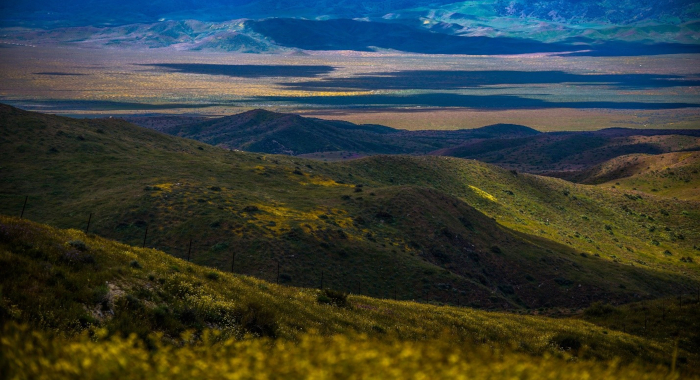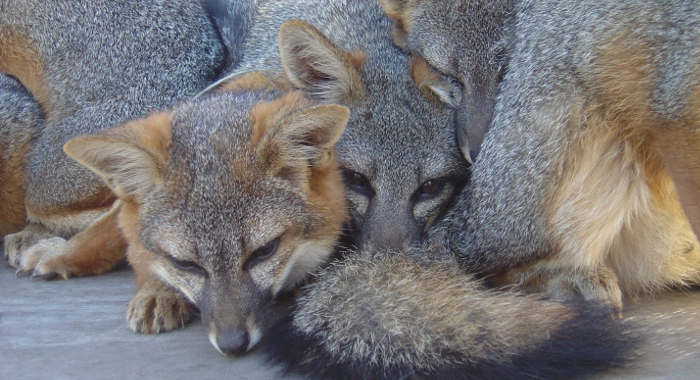Nearly half of California is protected in some land status that prevents most kinds of intensive human land uses. These lands support extensive natural habitats, and for many species, are a critical stronghold in an increasingly human-dominated world.
Yet, changes in the landscape in and near these places have left many in a degraded and precarious condition. Catastrophic wildfire, invasive species, and climate change threaten vast swathes of the state. Protected lands are becoming increasingly isolated by urban and agricultural development, roads, and other infrastructure. Such obstacles can limit a species’ ability to move to across the landscape and adapt to climate change.
Conservancy scientists are working to enhance the resiliency of protected lands in the face of rapid change, and to maintain the landscape connections necessary for plants and animals to adapt over time.


Michael Clifford, Sophie Parker, Matt Rader, Lydia Bailey, Naomi Fraga, Chris Hass, Estella Hernandez, Jan Kempf, Lois Merkler, Michael Swink
The Amargosa River supports one of the most outstanding suites of endemic and imperiled species in the world. In 2019, TNC acquired the Atwood Preserve in the river’s headwaters, the…Michael J. Clifford, Sophie S. Parker, Brian S. Cohen, Elaine York, Joel Tuhy
This paper provides an assessment of changes in the conservation value of lands in the Mojave Desert of Nevada and Utah resulting from renewable energy and other development between 2010 and 2018. The…The Nature Conservancy with Willis Towers Watson, Sarah Heard
California has the highest wildfire risk in the US, and climate change will continue to exacerbate the risk, at least in the foreseeable future. As a result, California is facing an insurance crisis,…Adam H. Love, Andy Zdon, Naomi S. Fraga, Brian Cohen, Maura Palacios Mejia, Rachel Maxwell, Sophie Parker
This paper presents results from the Mojave Desert Springs research project. The authors present a comprehensive statistical analysis of similarities between California desert springs. An observed…Kristen E. Dybala, Kristin. A. Sesser, Matthew E. Reiter, W. David Shuford, Gregory. H. Golet, Catherine Hickey, and Thomas Gardali
Conserving birds is a key goal for management of the Sacramento–San Joaquin Delta ecosystem, one of the largest estuaries on the Pacific Coast, and is likely to have effects for populations well…Jasmine Lu, Emily E. Hamblen, Lara J. Brenner, Julie L. King, Bridgett M. VonHoldt, Alexandra L. DeCandia
Over 50% of federally threatened Santa Catalina Island foxes (Urocyon littoralis catalinae) develop life-threatening ceruminous gland tumors in their ear canals. Previous work suggests that tumors may…Naomi S. Fraga, Brian S. Cohen, Andy Zdon, Maura Palacios Mejia, Sophie S. Parker
This paper presents novel botanical inventories of 48 desert springs as part of the Mojave Springs Research Project. The authors assess plant species composition and richness within and between…Grace C. Wu, Ryan A. Jones, Emily Leslie, James H. Williams, Andrew Pascale, Erica Brand, Sophie Parker, Brian Cohen, Joseph Fargione, Julia Souder, Maya Batres, Mary G. Gleason, Michael H. Schindel, Charlotte K. Stanley
This paper presents the results of the Power of Place-West project. The authors combined energy modeling with ecosystem and wildlife habitat data to determine the costs and impacts associated with…Charles J. Maxwell, Robert M. Scheller, Kristen N. Wilson, Patricia N. Manley
The authors hypothesized that mimicking the historic fire-return interval, by matching it with the combined frequency of natural disturbances (wildfire) and management (i.e., thinning and…Victor Y. Zhang, Calypso N. Gagorik, Lara J. Brenner, Christina L. Boser, Tad C. Theimer, C. Loren Buck
Despite occupying similar niches in a relatively resource-poor environment, island foxes and island spotted skunks have coexisted for years through fine-scale spatial, temporal, and dietary niche…Sophie S. Parker, Linnea S. Hall, Mary J. Whitfield, Laura Riege, Kathryn R. Selm, René Corado
This paper presents results from a field-based study that can be used to benefit songbirds in riverside habitats like those found along the Santa Clara River in Ventura County, California. Songbirds…Maria C. Viteri, Elizabeth A. Hadly
This paper investigates the ability of small protected spaces to conserve small mammal diversity in urban areas. The authors identified small mammal bones from both modern owl pellets and…Sophie S. Parker, Bradley Franklin, Brian S. Cohen, Melissa M. Rohde, Michael Clifford, Andrew Williams
Climate change will cause severe financial, social, and environmental upheaval if a massive reduction in carbon emissions is not achieved by 2030. To address this challenge, rechargeable lithium-ion…Christopher J. Lortie, Maria Florencia Miguel, Alessandro Filazzola, Harry Scott Butterfield
Climate change, drought, and water scarcity are driving major land transformations in dryland ecosystems globally. Historically these ecosystems have been disproportionately degraded due to widespread…D. Richard Cameron, Carrie A. Schloss, David M. Theobald, Scott A. Morrison
Protecting or restoring habitat connectivity in landscapes undergoing rapid environmental change requires multiple conservation and restoration strategies. These strategies have different risk…Carrie Schloss, Dick Cameron, Elizabeth McGovern
As declines in biodiversity are further exacerbated by changing climate conditions, it is critical to ensure that plants and animals are resilient to the effects of climate change. This means…